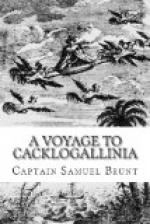But the century which elapsed between Godwin’s fanciful tale and Brunt’s fantastic romance felt the impact of the new science. No matter how clearly both tales draw from old traditions of legend and literature, no matter how many elements of fantasy remain, there is a profound and fundamental difference between them. Godwin’s hero made his way to the moon by mere chance; it happened that he harnessed himself to his gansas during their period of hibernation. Too late, he discovered that gansas hibernate in the moon! The earlier voyage took only “Eleven or Twelve daies”—and that by gansa power! The earlier author did not suggest that his hero encountered any particular difficulties of respiration, nor did he pause to consider in detail the problem of the nature of the intervening air through which his hero passed.
But a hundred years of science had intervened between Godwin’s tale and that of Captain Samuel Brunt. The later voyage to the moon is no less fantastic in its outlines than is the earlier, yet it shows clearly the impact of science upon popular imagination. The imagination of man had expanded with the expanding universe. Brunt takes care to indicate the vast distance between the earth and the moon by subtle mathematical suggestion. Although both travelers flew “with incredible swiftness,” the eighteenth-century flyers found that it was “about a Month before we came into the Attraction of the Moon.” Brunt’s account of the preparation for the ascent into the orb of the moon is almost as careful as a modern account of an ascent into the stratosphere. His bird flyers lay their plans deliberately and upon the basis of the most recent scientific discoveries. There is nothing fortuitous about their final ascent. Brunt was clearly aware of the work of many scientists, notably Boyle, upon the nature and rarefaction of the air. His flyers proceed by slow stages, accustoming themselves gradually to the rarefied air, assisting their respiration by the use of wet sponges. They learn by experience the answer to the problems with which Godwin’s mind had played but which many later scientific writers had considered more definitely: what is the nature of gravity; how far beyond the confines of the earth does it extend; what would happen to man could he “pass the Atmosphere”? The generation to which Captain Samuel Brunt belonged might still delight in the fantastic; but like our own generation, it insisted that fantasy must rest upon that which is at least scientifically possible, if not probable.
A Voyage to Cacklogallinia is republished today because of its appeal to many readers. It offers something to the student of economic history; something to the student of early science. It is one of several little-known “voyages to the moon,” of which the most famous are those of Cyrano de Bergerac, a form of reading in which our ancestors delighted and which deserve to be collected. But apart from having a not-inconsiderable historical interest, it




